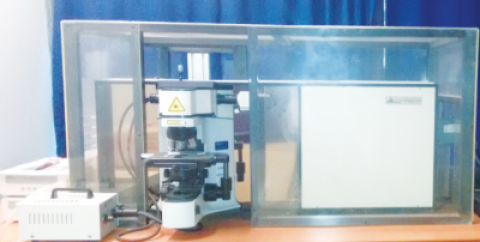
.
Category
- Spectroscopy and Spectrometry » Raman Spectrometer
Booking Details
Facility Management Team and Location
Prof. Leela S. Panchakarla
Facility Features, Working Principle and Specifications
- Imaging/Mapping:
XYZ mapping:
XY stage :X=75 mm and Y=50 mm , 1 µm repeatability
Step-by-step mode: step size (min) 50 nm
Z stage min step = 0.1 µm
Duoscan Mode with scanning mirror.
Scanning/Averaging followed by Macro mapping for large area mapping
- Polarization dependent Raman Scattering :Range 400 – 700 nm
- Low Temp : Min 80K
Raman scattering is an inelastic scattering of incident light from vibrating atoms or molecules or from electronic states like plasmons, coupled plasmon-phonon states etc with change in the wavelength. It consists of Stokes and anti-Stokes components depending on whether the scattered wavelength is greater or less than the incident one. Thus Raman spectrum from a sample consists of several lines characteristic of the unique vibrational modes of the sample and has turned out to a fast and reliable non-destructive technique for characterization, material property studies under different sample environment. However the Raman scattering efficiency is very poor and ≈ 10-3 – 10-5 times the elastically scattered Rayleigh component and requires a powerful excitation source. The excitation sources are generally UV/VIS/NIR CW laser sources with high incident photon flux and detection is by highly efficient CCDs. The change in the wavelength of the scattered radiation is analyzed using a single/multiple grating high resolution UV-visible-NIR optical spectrometer/spectrograph. The spectrometer should possess a very high rejection capability of the elastically scattered Rayleigh component from much weaker Raman scattered light. This is usually achieved by two or three stage spectrometers or more recently by single stage spectrometers with highly efficient Holographic Notch filters or sharp cutoff dielectric edge filters.
Instructions for Registration, Sample Preparation, User Instructions and Precautionary Measures
- Samples can be solid in form of powder, thin film or bulk pallets. Solid samples should preferably not exceed size of 50 mm X 50 mm X 20 mm and not weigh more than 100 gms.
- Sample should be nontoxic and non radiactive.
- Liquid samples will be done in thin walled (< 0.5 mm and 2 mm OD ) glass/quartz capillary tubes. Users are required to bring samples in sealedcondition.
- Only online registration will be accepted. If you need to cancel your slot, send an email immediately to with an explanation. Else user will be blocked after two repeat ‘no show’
- Slots will be provided on a first-come first-served basis as far as possible.
- The slots are from 10.30–12.00, 12.00 – 13.30, 14.30- 16.00, 16.00 – 17.30 hrs. You can request two consecutive slots only once in a week. If your experiment needs more time (e.g. Mapping/Imaging.), please indicate area, mapping step, scan range (cm-1) and integration time so that we can deal with your specific requirement.
- USB drives are strictly forbidden for copying data to minimize virus-related issues. You need to bring a new blank CD to transfer your data. All data must be transferred within 7 days without exception.
- Users must be available throughout the course of data acquisition.
Charges for Analytical Services in Different Categories
Applications
Sample Details
SOP, Lab Policies and Other Details
Publications
- Singh K, Singh A. Effect of austempering temperature on corrosion evolution during immersion of high carbon nano structured bainitic steel in aqueous chloride environment. Materialia. 2022, 21:101282.
- Singh AK, Mandal KK, VS AA, Kumar A, Dixit S, Kumar A. Introducing ‘low cost large scale’hydrophobic SERS substrate. InNanoengineering: Fabrication, Properties, Optics, Thin Films, and Devices XVIII 2021 Vol. 11802, p. 1180206.
- Sahoo NR, Dixit S, Singh AK, Nam SH, Fang NX, Kumar A. High Temperature Mid‐IR Polarizer via Natural In‐Plane Hyperbolic Van der Waals Crystals. Advanced OpticalMaterials. 2022;10(4): 2101919.
- Mishra GK, Gautam M, Sau S, Mitra S. Surface Modified Lithium Cobalt Oxide (LiCoO 2 ) with Enhanced Performance at Higher Rates through Li Vacancy Ordering in the Monoclinic Phase. ACS Applied Energy Materials. 2021 Dec 1;4(12):14260 72.
- Pathak SS, Panchakarla LS. A large area flexible p type transparent conducting CuS ultrathin films generated at liquid liquid interface. Applied Materials Today. 2021; 24: 101152
- Panda S, Aditya MV, Tatiparti SS. Synergetic effect of C and Ni on hydrogen release from Mg Ni electrochemically synthesized reduced graphene oxide based hydride. Sustainable Energy & Fuels. 2021;5(17): 4414 24.
